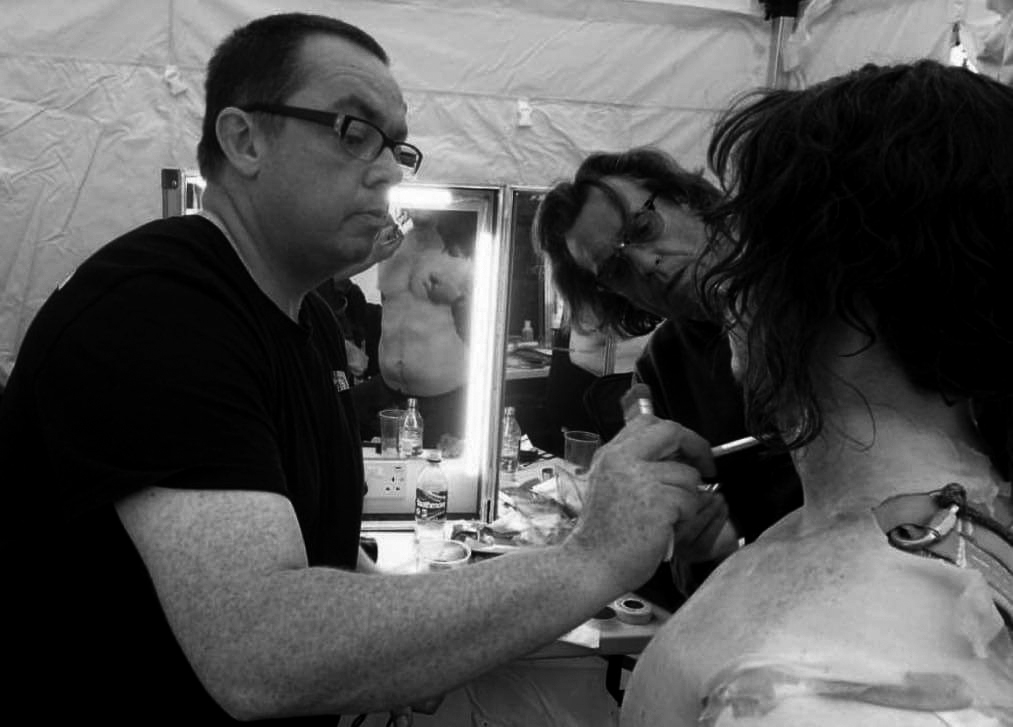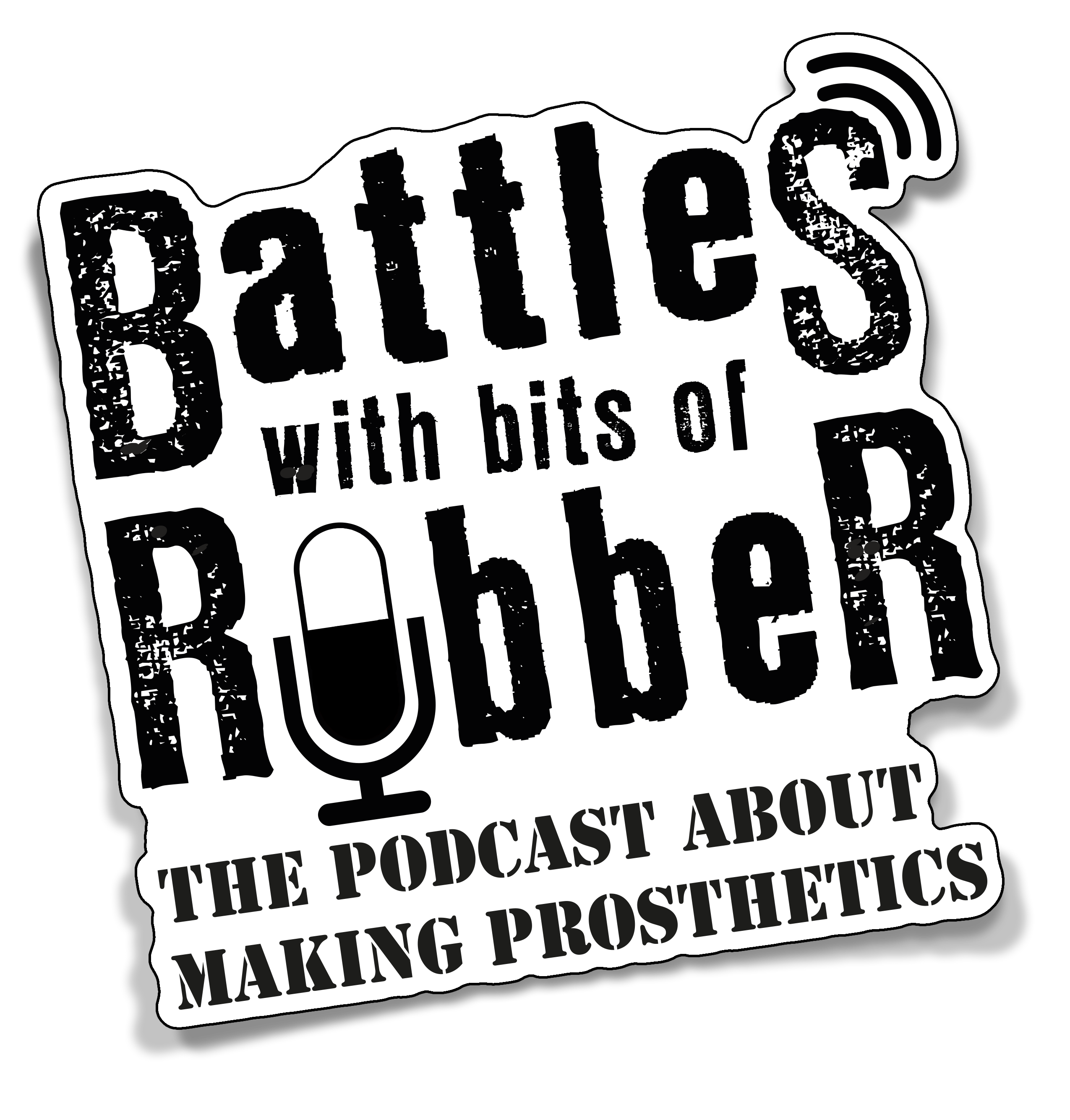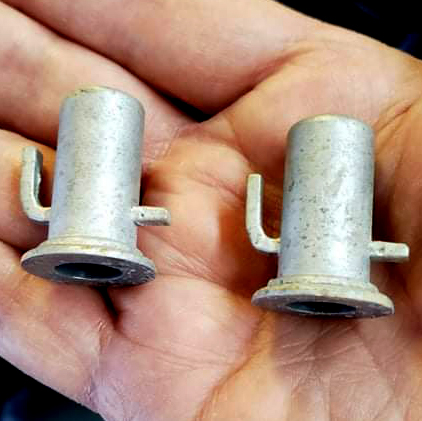
In this episode, we talk with materials maestro Pete Tindall about all things making related, along with a dose of rantage. Having worked with him recently on a movie, I can vouch for his credentials.
I moan a bit about ZBrush (although I love it) and the fact that despite the terrifying interface and the huge number of tools available in ZBrush, freedom comes from accepting that you likely need only a handful of them. Early on in ZBrush, you are can indeed happily ignore most of it with confidence.
Pete is an adept materials man, knowing and using a broad range of materials. We first met on Batman Begins (2005) where Pete worked in the Bat-suit workshop and miniatures for the monorail sequence.
To listen to the podcast, you can stream or download from here, or simply subscribe through your favourite podcast app – we are on many, including Spotify, Apple Podcasts, Soundcloud, IHeartRADIO , STITCHER , Luminary and Google Podcasts.
We also start the podcast as usual with a little FX chit-chat and this time we talk about creating the illusion of hard things in soft tissue such as horns protruding from foreheads, teeth showing from exposed gums and foreign bodies sticking out of the skin (knives or arrows for example).
In the reality of filming, the scene may need to be repeated and used in intense action, so things that are really hard or sharp in real life could break off or cause real injury.
As a result, often it is made up of either soft or semi-rigid material which looks solid but is safer. Sometimes the thing may be designed to break away, be replaceable if multiple takes are needed, be incredibly lightweight or even detachable so it can be removed when not needed.
All this can mean a huge amount of planning and design work ahead of time to ensure the fixtures, plates, skullcaps or other means of retention are built under any costume, wig or appliance. Because this stuff is not seen, it’s the importance of its craft is rarely appreciated.

You can imagine causing injury on set from a dangerous set of horns or making something so soft it wobbles noticeably as the hero runs into the scene…they can cause real problems to a shooting schedule.

Our discussion hits many points, mainly:
The fascination lies in creative making. The materials and techniques are transferable over so many departments from makeup, props, specialist costumes, action vehicles, miniatures and animatronics.

How does digital technology affect our practical side of the industry? March of progress is inevitable. New technology is changing how things are filmed and there is still a huge amount of practical work involved. Actors having the ability to interact with real things helps performance.
There is a long history of makeup, hair and prosthetics to draw on – there are people who have been sculpting and moulding for 50 years. The same depth of experience is not quite so readily available for digital, and certainly, although everything you could want to learn is to be found online, the field is vast and constantly expanding, breeding specialisms and niche areas of expertise.
Much technology used on productions is available at a consumer level and so there are basic versions readily available. This will enable a generation of artists to at least understand and utilise the technology in a way that was very separated before – 40 years nobody was really rotoscoping in their basement but the version of ZBrush on my laptop is the same at ILM.
Having all been brought up without the internet and computers, we all feel the benefits they bring. It is all about WHAT you do with what you have, rather than having everyone relying on the tools.
We need the DICK SMITH of ZBrush! New heroes are out there now ready to be discovered.
Pete shows a real passion for materials and how they can be utilised and experimented with, and it is an infectious spirit that he enjoys sharing with students. Like many working artists, he will teach on occasion between shows. It is a great way of keeping up to date with the latest working practices in the industry as well as the current state of FX education.
Then we went off on a bit of a grumpy old man rant. Particularly we want to acknowledge the crews behind any endeavour. In a world where we believe in spectrums of many kinds, there is often a polarised/binary view of success being based on popularity and ‘fame’ rather than on competency and the value you can bring to something.
We talk a bit about how seeing the world’s best of everything on your Instagram feed can make us feel inadequate. The key thing is to measure yourself against how you were ‘yesterday’ rather than someone else’s ‘today’.

The cast member and performance make a big difference in how effective makeup can be. We have all seen awkward-looking orcs who don’t look so fearsome without the right posture, or indeed the surroundings of Middle earth to support them.
We see great makeup on great performers who work it and become different people for the camera. That is a lot to ask of Dave from accounts or whoever gets pressed into service. I think it is a fair point to choose your model to suit the makeup – or if this isn’t an option then choose a makeup that will better suit a performer.

The amount of glum-looking ‘Avatar’ style Na’vi I have seen ….take that same person and give them different ears and change the jawline and they would instead become a bankable folio piece.
The joy of working on your own projects when time constraints are not there. You can make mistakes and take your time, not even necessarily to post or show anyone, but for the sheer joy of doing the work and finding new things. Those lessons carry on through other work and build your skills.
5 Point Plan
It’s all well and good dissecting what we think is good and bad, but how can all that misty-eyed nostalgia be turned into succinct and useful advice for the would-be student of effects? We throw together a 5-point plan. With 7 points.
That’s a 40% bonus.
- Learn what good work is and who is doing it. Get to know the big hitters and where they came from, who they learned from and how they do their work.
Watch the credits on shows you like, as these names are doing the work you are looking to do. Take notes and look them up on places like IMDb.
- Check where you are in the pecking order. There is a spectrum of work, good to bad, and so a realistic idea of where you sit on there and noticing when you improve is good.
Working as part of a team depends on you happily filling your shoes as a component. Backstabbing and sneaking your way to the top doesn’t work. Thinking of yourself as more able than you actually are is also a recipe for resentment. Pay attention to what people are doing and how they do it.
- Don’t be a dick. Being someone that others want to be around and work with is just as important as your working ability.
If there are two sculptors up for a job, the one who is pleasant to be around will have a huge advantage. A talented artist who is difficult to work with isn’t much fun. - Start playing with digital.
Nomad and Forger are pretty inexpensive. ZBrush Core Mini is currently free and there is a wealth of free tutorials on YouTube. Start playing and get comfortable with them. - Start making but start small and grow gradually in scale and complexity. Don’t feel pressured to start a huge project. Failing on something small is far cheaper with a quicker turnaround time and less devastating to the ego. We know because we have all done it.
A nose is a great place to start – plaster moulds and slip latex. Cheap and quick, you will find out what you don’t know fast and for not a lot of money.
Trying to turn a 20-year-old with perfect skin into a 100-year-old isn’t likely to work, and would not make a great first project. Make a 20-year-old look like a different 20-year-old is a far more realistic (and useful) skill.
- Know your materials. There are many ways of doing something, and your place of education may have a limited range of materials. Keep your mind open to new materials, suppliers and techniques.
Knowing your materials also means when you have a material failure (because of a contaminated bad batch, incorrectly labelled or something past it’s ‘use by’ date) you can feel confident as much of the fault is yours and how much lies with the material itself. - Use reference. It will keep you on a truer track and you will learn more. You may need to be creative about what reference to use as images of the exact thing may not exist – so be creative and think laterally.
What could resemble the effect you need elsewhere in nature? Rock formations, bone cross sections, fungi, insect macrophotography, dried coffee splashes…. inspiration and natural patterns are everywhere if you keep your eyes open.
We get a bit ranty talking about lost skills and reduced attention spans. All good technicians are essentially problem-solvers, and so we again make a call to arms: Competency is good. Skills are learnable. What needs to happen first is your desire to acquire and utilise those skills.
There is a bit of material safety chat, and more material tips and tricks.
We get into the ‘flow state’ where time slips by unnoticed, you get so involved and in tune with your task that it occupies you utterly.
Links
Steve Wang podcast (episode number 31 http://www.learnmakeupeffects.com/31-steve-wang/).
Biresin U1419 SikaAxson https://www.neillsmaterials.co.uk/product/biresin-u1419/
Many thanks, as always, for your time checking the stuff out. You can email us directly at stuartandtodd@gmail.com or leave us a voice message on our site.
If you enjoy this podcast and got something out of it, would you do us a solid and tell just one more person about us? Send them a link and help us grow!
–Stuart & Todd
To listen to the podcast, you can stream or download from here, or simply subscribe through your favourite podcast app – we are on many, including Spotify, Apple Podcasts, Soundcloud, IHeartRADIO , STITCHER , Luminary and Google Podcasts.







 #83 – Ian Morse & Cliff Wallace Part 2
#83 – Ian Morse & Cliff Wallace Part 2